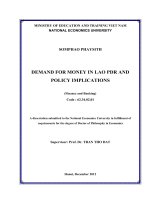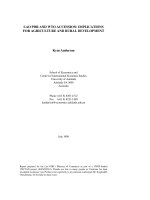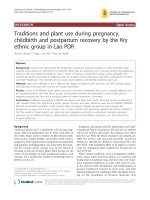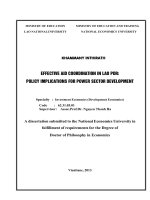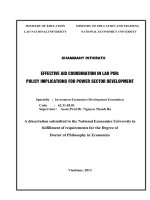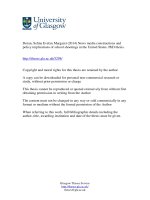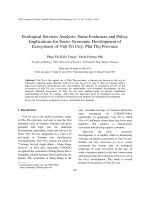Demand for money in Lao PDR and policy implications
Bạn đang xem bản rút gọn của tài liệu. Xem và tải ngay bản đầy đủ của tài liệu tại đây (1.72 MB, 144 trang )
Header Page 1 of 123.
MINISTRY OF EDUCATION AND TRAINING VIET NAM
NATIONAL ECONOMICS UNIVERSITY
SOMPHAO PHAYSITH
DEMAND FOR MONEY IN LAO PDR AND
POLICY IMPLICATIONS
(Finance and Banking)
Code : 62.34.02.01
A dissertation submitted to the National Economics University in fulfillment of
requirements for the degree of Doctor of Philosophy in Economics
Supervisor: Prof. Dr. TRAN THO DAT
Hanoi, December 2012
Footer Page 1 of 123.
Header Page 2 of 123.
i
DECLARATION
I hereby declare that this doctoral dissertation “Demand
for money in Lao PDR and policy implications” is written by
me and has not been published yet.
I am responsible for my declaration.
Somphao Phaysith
Footer Page 2 of 123.
Header Page 3 of 123.
ii
ACKNOWLEDGEMENT
First of all, as the Governor of the Bank of the Lao PDR, I am very
pleased and greatly honored for taking the opportunity to take part in the
doctoral program organized jointly between the National University of Laos
and National Economics University of Vietnam. After a number of years
following this program, my study is devoted to the title: “Demand for Money
in Lao PDR and Policy Implications”.
I would like to express my heartfelt appreciation to the Lao People’s
Revolutionary Party and Ministry of Education and Sport of Lao PDR for
granting me this opportunity to undertake this rewarding doctoral program
and achieve the result successfully as my wish comes true.
As one of the candidates for this program, I would like to extend my
gratitude and appreciation to the leaders and management staff of these two
universities for making this program possible to enhance capacity building for
Lao leaders, who are well qualified from the program. During the five-year
program, I have got the close guidance and knowledge from the lecturers of
the two universities as well as relevant authorities for their support that enable
me to ease difficulties and hurdles and to complete the program successfully.
My achivement is also due to valuable academic support from Prof. Dr.
Tran Tho Dat, my academic advisor and close supervisor for my research,
who enable me to fulfill all requirements of the doctoral program on a timely
manner. My special thank also goes to Assoc. Prof. Lai Phi Hung, the
program coordinator. I would also like to extend my profound appreciation of
wholehearted assistance and cooperation between our two nations, Lao PDR
and Vietnam.
Footer Page 3 of 123.
Header Page 4 of 123.
iii
My research is carried out with the staff development grant from the
Bank of the Lao PDR. Furthermore, I shall not forget and pay tribute to kind
support and sincere assistance rendered by the BOL staff, namely Ms.
Fongchinda Sengsourivong, Mr. Soulysak Thamnuvong, and Mr. Khamkeo
Visisombath.
Lastly, my profound thanks go to my beloved family, including my wife
and my two daugthers for their encouragements, care and motivation during
my research. They always provide me very important supports, and love
during the period of hardship. All of their supports provided are the power
injecting to me to strive the various difficulties and to complete the program
successfully as the task assigned by the Party and Lao people.
Footer Page 4 of 123.
Header Page 5 of 123.
iv
TABLE OF CONTENTS
DECLARATION........................................................................................................ i
ACKNOWLEDGEMENT........................................................................................ ii
TABLE OF CONTENTS......................................................................................... iv
ABBREVIATION .................................................................................................... vi
LIST OF TABLES .................................................................................................. vii
LIST OF FIGURES ............................................................................................... viii
LIST OF VARIABLES............................................................................................ ix
INTRODUCTION..................................................................................................... 1
CHAPTER I: OVERVIEW OF THEORETICAL
AND EMPIRICAL
STUDIES ON MONEY DEMAND ......................................................................... 7
1.1.
A brief theoretical overview......................................................................... 7
1.1.1. Quantity theory of demand for money ........................................................... 7
1.1.2. Keynesian approach (John Maynard Keynes) .............................................. 10
1.1.3. Friedman’s model of the demand for money ............................................... 14
1.2.
Some empirical problems in estimating money demand functions............... 15
1.2.1. Functional forms........................................................................................... 16
1.2.2. Choice of variables ....................................................................................... 17
1.2.3. Empirical estimation problems ..................................................................... 20
1.3.
Some Asia-specific studies on the money demand function.................... 23
Conclusion of chapter 1 .......................................................................................... 28
CHAPTER II: LAO FINANCIAL SYSTEM AND MONETARY POLICY.... 31
2.1.
Economic development............................................................................... 31
2.2.
Overview of monetary developments in Lao PDR .................................. 34
2.3.
Banking system ........................................................................................... 35
2.3.1. Mono-bank system. ...................................................................................... 37
2.3.2. Banking system reform................................................................................. 40
2.4.
Monetary Policy .......................................................................................... 47
2.4.1. Monetary instruments. .................................................................................. 47
2.4.2. Target of monetary policy ............................................................................ 51
2.5.
Dollarization................................................................................................ 54
2.6.
Bond market................................................................................................ 56
Footer Page 5 of 123.
Header Page 6 of 123.
v
2.7.
Stock market ............................................................................................... 58
2.8.
Interbank market ....................................................................................... 59
2.9.
Exchange rate policy .................................................................................. 60
Conclusion of chapter 2 .......................................................................................... 66
CHAPTER III: DEMAND FOR MONEY IN LAO PDR ................................... 67
3.1.
The theory-based money demand function for Lao PDR....................... 67
3.2.
Data description and issues........................................................................ 69
3.2.1. Definition of money...................................................................................... 69
3.2.2. Scale variable................................................................................................ 71
3.2.3. Opportunity costs.......................................................................................... 71
3.3.
Unit root and co-integrated test ................................................................ 73
3.3.1. Unit root test ................................................................................................. 73
3.3.2. Johansen co-integration test.......................................................................... 74
3.4.
Estimating money demand function for Lao PDR by using ECM............ 76
3.4.1. Engle and Granger: Error Correction Models .............................................. 76
3.4.2. Estimated results and hypothesis testing ...................................................... 77
Conclusion of chapter 3 .......................................................................................... 92
CHAPTER IV: POLICY IMPLICATIONS......................................................... 93
4.1.
Lao economic development strategy ......................................................... 93
4.1.1. Macro-economic targets ............................................................................... 93
4.1.2. Targets of Economic Sectors ........................................................................ 94
4.2.
Monetary policy recommendations........................................................... 98
4.2.1. Monetary instruments ................................................................................... 99
4.2.2. Choosing intermediate target........................................................................ 99
4.2.3. Increasing banking supervisor .................................................................... 101
4.3.
Some recommendations to Lao government .......................................... 102
4.3.1.
Dedollarization .......................................................................................... 102
4.3.2.
Stimulate financial market development ................................................... 104
CONCLUSION...................................................................................................... 106
REFERENCE ........................................................................................................ 108
APPENDICES ....................................................................................................... 114
Footer Page 6 of 123.
Header Page 7 of 123.
vi
ABBREVIATION
Lao PDR
Lao People’s Democratic Republic
Laos
Used under monarchy regime
BOL
Bank of the Lao PDR
MOF
Ministry of Finance
BCEL
Banque Pour le Commerce Exterieur or Bank for Foreign
Trade Lao
LDB
Lao Development Bank
APB
Agricultural Promotion Bank
SOCBs
State-Owned Commercial Banks
GDP
Gross Domestic Product
Kip Khangkhay
Banknotes issuing by tri-parties of the coalition
government in 1962
Kip Potpoi
Liberated currency under Lao Patriotic Front
NPL
Non-Performing Loans
RR
Reserve Requirement
CIB
Credit Information Bureau
Footer Page 7 of 123.
Header Page 8 of 123.
vii
LIST OF TABLES
Table 1.1:
Estimated income elasticity and interest rate semi-elasticity for
selected Asian countries...................................................................... 26
Table 3.1:
Unit Root Test Results ........................................................................ 78
Table 3.2:
Likelihood ratio test: lag lengths test .................................................. 79
Table 3.3:
Johansen test: the λmax and λtrace tests results at 5% ........................... 80
Table 3.4:
Diagnostic tests for the short-run dynamic money demand model,
equation (3.9) ...................................................................................... 82
Table 3.5:
Short-run dynamic estimation, dependent variable is ∆ ln rmt ............ 90
Table 3.6:
Long-run relation, dependent variable is ln rmt .................................. 91
Table 4.1:
Nonperforming loans ratio and number of banks in Lao PDR ......... 102
Footer Page 8 of 123.
Header Page 9 of 123.
viii
LIST OF FIGURES
Figure 1.1: Determinants of money demand function........................................... 30
Figure 2.1: GDP growth (1991-2011) ................................................................... 33
Figure 2.2: GDP by Components (billion Kip) ..................................................... 33
Figure 2.3: GDP growth, Inflation rate, M2 growth, M2 to GDP and FX to
total deposit. ........................................................................................ 35
Figure 2.4: Interest rates of deposits and loans in Kip .......................................... 50
Figure 2.5: Monthly loans interest rates by currency (%) ..................................... 50
Figure 2.6: Money supply- M2 (billion Kip)......................................................... 52
Figure 2.7: Deposits by currency (%).................................................................... 55
Figure 2.8: Relationship between M2, inflation and exchange rate (%)............... 63
Figure 2.9: Exchange rate (Kip/USD) movement (%) .......................................... 65
Figure 2.10: Average exchange rate (Kip/USD) ..................................................... 65
Figure 3.1: Cumulative Sum of Squares of Recursive Residuals.......................... 82
Figure 4.1: Money and interest rate targets ......................................................... 100
Figure 4.2: Lao money multiplier and velocity, January, 1999 – September,
2012................................................................................................... 101
Footer Page 9 of 123.
Header Page 10 of 123.
ix
LIST OF VARIABLES
M
Total amount money in circulation
T
Level of transactions
Y
Output
V
Transaction velocity of money
P
Prevailing price level
Md
Money demand
MD
Total demand for money
M1
Sum of transaction and precautionary demands (narrow money)
M2
Speculative demand (broad money)
tc
Transaction costs
r
Interest rate
M/P = rm
Demand for real balances
πe
Expected inflation rates
i
Nominal interest rate
GNP
Gross National Product
NNP
Net National Product
GDP
Gross Domestic Product
ln
Natural logarithm
∆
First differenced term
cpi
Consumer price index
er
Exchange rate
π xt − p
Error-correction factor
EC t −1
Error-correction term
Footer Page 10 of 123.
Header Page 11 of 123.
1
INTRODUCTION
International experiences confirm that countries with well-developed
financial systems grow faster and more consistently and are better able to adjust
to economic shocks. A good financial market and system of institutions can
channel funds from savers to the most productive investors. A typical financial
system in a transitional economy, especially banking system has limited capacity
to assess credit risks and fund allocation according to the government plans.
Furthermore, governments have strong controls over the financial systems, such
as setting interest rate ceilings, entry barriers, and interference in credit
allocation. According to McKinnon (1973) and Shaw (1973), such financial
repression leads to reduction in private savings, thereby decreasing the resources
available to finance capital accumulation, with a negative impact on growth.
The Lao PDR is in the process of transition toward a market economy, the
requirement of government’s operations to change its intervention methods and
scope is a fundamental process. One of these fundamental changes is the way the
government conducts its monetary policy as well as the development of the
financial system, especially the banking system to achieve desirable economic
growth. The relationship between monetary growth and economic growth is still
in debate. Hossain and Chowdhury (1996, p.126) argued that there is a clear
correlation between money supply growth and economic growth in the long-run.
Other studies in the field also point out the importance of monetary policy,
especially, in managing the demand side of the economy.
In order to make the monetary policy more efficient and effective, the
prerequisite for the monetary authority must be able to predict the demand for
money with acceptable accuracy. Theoretical views of the demand for money
have usually been based on the consideration of money as a medium of
Footer Page 11 of 123.
Header Page 12 of 123.
2
exchange. The Keynesian models represent money with the role of
transactions and the role of the store of value. Analytically, demand for
money is the sum of three components: transactions, precautionary, and
speculative demand. Milton Friedman argued that physical goods should be
regarded as a substitute for money and that higher expected rates of inflation
should induce a portfolio shift from money to physical assets as well as
financial assets (hard currencies) in the context of transition and
underdeveloped countries. The fact that money does not bring interests like
other alternative assets means that money holders should receive
compensation in some other forms. Following the idea of Keynes, many
economists attempted to model the demand for money based on the above
consideration. Although they are different technically, the main idea is still
based on the so-called ‘liquidity services’, which money gives in
compensation for the interest earning foregone.
The relationship between the demand for money and its key
determinants is an important building block in macroeconomic theories and is
a crucial component in the conduct of monetary policy (Goldfeld, 1974).
Even in the era of inflation targeting, a well-specified money demand function
is of utmost importance for the effective implementation of monetary policy –
especially to track both, the interest rates and the stock of money – in order to
access the impact of monetary policy upon the economy. As a result, the issue
of long-run relationship between broad money, its determinants and also the
stability of the demand for money has always been in the center of research.
Stable money demand is particularly important for policy makers to
choose a credible monetary policy instrument. For instance, unstable money
demand caused by the financial reforms of the late 1970s, the financial
innovations and the financial integration induced many central banks in
Footer Page 12 of 123.
Header Page 13 of 123.
3
developed countries to switch from monetary targeting to the interest rate
targeting as a monetary policy instrument. The same view was proposed by
Poole (1970) who showed that the interest rate should be targeted if the
money demand function is unstable. However, monetary targeting can play an
important role in the formulation of an efficient monetary policy strategy,
even though the monetary policy of developed countries typically uses an
interest rate target as a policy instrument. Monetary aggregates can be
appropriate indicators for future inflation in the medium term and long-term.
As mentioned by Valadkhani (2006) an emerging consensus among
economists is that it is not advisable to concentrate exclusively on a single
policy instrument while neglecting another important information variable.
Both interest rates and monetary aggregates are important in selecting
appropriate monetary policy actions. Monetary aggregates, however, will only
be related to the real economy if the money demand function is stable. Thus,
the stability of money demand entails whether monetary targeting is an
appropriate guide to policy.
Due to its particular importance, the money demand function was studied
extensively in many countries as can be seen from a large body of literature
on theoretical as well as empirical studies of the demand for money, discussed
in Chapter I. However, these studies had been largely carried out in developed
countries. One explanation for that is the lack of good quality data in
developing countries. Lao PDR is not an exception in that respect. Indeed, the
poor quality and short time horizon of Lao economic data is well known
among researchers. One main reason is that Lao PDR just adopted the system
of national accounts (SNA) in 1993 and the statistical system is still
underdeveloped.
The dissertation titled “Demand for money in Lao PDR and policy
implications” can be viewed as the earliest research in the case of Lao PDR.
Footer Page 13 of 123.
Header Page 14 of 123.
4
This fact, while telling us about many difficulties, also can be viewed as an
encouraging attempt for us since ‘learning by doing’ in many cases may be
the best strategy.
Objectives of research
The main purpose of this dissertation is to estimate the money demand
function for Lao PDR during the period of the first quarter of 1993 to the
second quarter of 2010 (1993Q1-2010Q2), using available data. Taking into
account the limitations mentioned above, the conclusion of the dissertation
should be viewed as a suggestion. However, by doing so it is hopefully to
establish an appropriate framework for future studies in this field once the
comprehensive data are available. In addition, the results of this study can
hopefully reveal some important issues and areas required to improve,
especially data problems which will raise awareness among policy makers to
improve the quality of the economic database of the country.
Research Questions
The main research question: What is the money for demand in the Lao PDR?
The specific research questions:
1. What is the behavior of money demand patterns?
2. How has the money demand contributed to the monetary stability in
monetary policy?
3. What are direct and indirect factors influencing the demand for money
in the Lao PDR?
4. What are the problems and obstacles confronting the Lao PDR in
conducting monetary policy?
Research Methodology
In light of analyzing the money demand function for Lao PDR, this study
Footer Page 14 of 123.
Header Page 15 of 123.
5
uses a basic and popular theoretical framework surrounding the money
demand analyzed from various empirical works. After formulating the
theoretical model, this dissertation adopts a framework of the Error
Correction Model, which is widely used, to analyse the money demand in
both developed and developing economies, to examine factors driving money
demand balances in Lao PDR over a period of 1993-2011. This econometric
model, an Error Correction Model is believed to be well-suited for the
empirical investigation through rigorous empirical testing.
Contribution of the study
To the best knowledge of the author, the current study represents the first
attempt to examine the factors influencing money demand for Lao PDR. This
study will provide a quantifiable estimation of the money demand in Lao PDR
for the first time by using quarterly data. The outcome of the study can be useful
for the purpose of conducting monetary policy for policy makers of the country’s
central bank. The economic variables which are used to conduct monetary policy
identified in this study will be helpful to systematically consider monetary policy
and facilitate policy discussions in the country. The outcome will provide
information needed for key decisions to formulate the future design of monetary
and exchange rate policies, which will significantly impact overall
macroeconomic stability. The findings will be useful for central bankers to
understand the factors influencing money demand in the Lao PDR, especially
taking into account of dollarization problems prevailing in the economy. The
study also updates the database of the Lao PDR financial statistics. One important
contribution of this study is in constructing economic variables especially annual
GDP data to quarterly GDP data. This provides a good starting point to study the
relationships between the money balance and other economic variables in the
economic framework. Further, this study can be adopted to estimate money
demand in other similar developing countries as the Lao PDR.
Footer Page 15 of 123.
Header Page 16 of 123.
6
Database
The data used in this analysis is taken from the Bank of the Lao PDR. The
estimated sample uses quarterly data in the period from Q1/1993 to Q2/2010.
Structure of dissertation
Besides the introduction, conclusion, appendices, references, this
dissertation includes 4 chapters as follows:
Chapter I: Overview of theoretical and empirical studies on money demand
This chapter reviews the main theories of money demand in order to
explore what factors can affect the demand for money. It also presents some
empirical studies on money demand. The lessons learned from the literature
survey will help select the appropriate modeling framework and choose
suitable variables in the following chapters.
Chapter II: Lao financial system and monetary policy.
The overview of financial system development of Lao PDR will be
presented in this chapter. In particular, major developments of the banking
sector in the last 20 years will be reviewed. The monetary policy will be
sketched with emphasis on the new role of the Bank of the Lao PDR. The
current pros and cons of BOL monetary policy raises the need to estimate the
money demand function.
Chapter III: Demand for money in Lao PDR
In this chapter, the empirical framework of money demand function for
Lao PDR will be formulated and estimated, the specific problems in the case
of Lao PDR will also be discussed.
Chapter IV: Policy implications.
Based on empirical estimation of chapter III, some policy implications
for not only the Lao government but also for the BOL will be suggested in
this chapter.
Footer Page 16 of 123.
Header Page 17 of 123.
7
CHAPTER I
OVERVIEW OF THEORETICAL
AND EMPIRICAL STUDIES ON MONEY DEMAND
1.1. A brief theoretical overview
1.1.1. Quantity theory of demand for money
The quantity theory of demand for money proposes a direct and
proportional relationship between the quantity of money and the prevailing
price level. This relationship emerges within the classical equilibrium
framework using two separate, but equivalent expressions. The first
expression is associated with American economist Irving Fisher and is called
the “equation of exchange”. The second expression is associated with
Cambridge University’s Arthur C. Pigou is called the “Cambridge approach”
or the “cash balance approach”.
• Fisher’s “equation of exchange”
The Fisher’s equation of exchange provides an important relation
between four macroeconomic variables to determine the nominal value of
aggregate income. 1 The four variables in the equation of exchange are the
total amount money in circulation, M, an index of the total value of aggregate
transactions, T, the price level of articles traded, P, and a proportionality
factor V denoting the “transaction velocity of money”. The equation is given
below:
MV = PT
(1.1)
The classical economists (including Fisher himself) built this
relationship in the nineteenth and early twentieth centuries. Since the classical
1
One should note that while Fisher developed the algebraic formulation of the equation of exchange in 1911,
it was John Stuart Mill who originally stated the relation, expanding on the ideas of David Hume.
Footer Page 17 of 123.
Header Page 18 of 123.
8
economists believed that wages and prices were completely flexible, they
posited that the level of aggregate output produced in normal economic period,
Y, would remain at the full employment level, so Y is by definition is nation’s
total potential level of output. Fisher assumed that the ratio between the level
of transactions, T, and output, Y, is reasonably stable ( Y = t × T ) and hence T
can be treated as constant in the short-run.
Fisher believed that the velocity of money, V, is determined by the
institutions in an economy, because these directly affect the way in which
individuals conduct transactions. For example, if consumers use charge
accounts and credit cards to conduct their transactions, and consequently use
money less often when making purchases, less money is required to conduct
the transactions generated by nominal income (M decreases relative to PT).
Hence, velocity, defined as ( PT ) / M , will increase. On the other hand, if
consumers find it more convenient to purchase items with cash or checks
(both of them are counted as money), more money is used to conduct the
transactions generated by the same levels of nominal income, hence velocity
will fall. Fisher theorized that institutional and technological features of the
economy that affect velocity change only slowly over time, so velocity can
safely be considered constant in the short-run. By dividing both sides of the
equation of exchange by V, we obtain the money demand function:
M d = (1 / V ) / PT
(1.2a)
M d = kPY
(1.2b)
Or equivalently,
Equation (1.2b) states that because k is a constant in the short-run
(because V and T are constant in the short-run), PY, pins down the quantity of
money that people demand, Md. Fisher believed that people hold money only
Footer Page 18 of 123.
Header Page 19 of 123.
9
to conduct transactions and have no freedom of action in terms of the amount
they want to hold. The demand for money is determined by the level of
transactions generated by the level of nominal income, PY, and by the
institutions in the economy that affect the way people conduct transactions
that determine velocity, V, and hence k. Therefore, Fisher’s quantity theory of
money suggests that the demand for money is purely a function of income.
Interest rates have no effect on the demand for money.
• Cambridge approach to money demand
A group of classical economists, including Alfred Marshall and Arthur C.
Pigou in Cambridge, England, studied the demand for money by considering
how much individuals want to hold, given a set of circumstances. This
approach is different from Fisher’s approach to money demand. Fisher held the
central assumption that individual demand for money is driven by the
institutional environment, as this is the main factor that affects whether
individuals use money (i.e., cash and check) to conduct transactions. In the
Cambridge model, the individual demand for money is not completely bound
by institutional constraints such as whether one can use credit cards to make
purchases. Instead, individuals desire money because money is a medium of
exchange and a store of wealth. Cambridge economists concluded that money
demand would be proportional to nominal income and expressed the demand
for money function as:
MD = kPY
(1.3)
In the short–run, k is the constant of proportionality and money demand
does not depend on the interest rate. However, money demand can depend on
the interest rate when velocity is not constant over time.
From our discussion so far, the quantity theory of money emerges as the
theory with a simpler approach to estimating money demand. The estimating
equation is
Footer Page 19 of 123.
Header Page 20 of 123.
10
MV = PY
(1.4)
Where M denoted nominal money stock, V denotes the income velocity
of circulation, P denoted the prevailing price level and Y denoted the real
income.
Note that the elegant expression for money demand given by the quantity
theory of money relies on the assumption of constant velocity. In reality,
however, the velocity is determined by technological and/or institutional factors,
which experience large changes, especially during periods of financial
liberalization. In these cases, equation (1.4) cannot capture the complex
relationship between the money demand and other macroeconomic variables.
Hence, we will turn to two other approaches to the theory of money demand:
the Keynesian approach and Friedman’s modern quantity theory approach.
Both approaches consider the demand for money as part of the general problem
of wealth allocation, but place emphasis on different aspects of the problems.
1.1.2. Keynesian approach (John Maynard Keynes)
In 1936, Keynes famous book, “The General Theory of Employment,
Interest and Money”, abandoned the classical view of economics. In its place,
he offered a theory of demand for money that emphasized the importance of
interest rates. Keynes’ theory of money demand (referred to as liquidity
preference theory), focuses on the factors that influence individual decisionmaking. He postulated that there are three motives driving the demand for
money: a transaction motive, a precautionary motive, and a speculative
motive. With this view, money demand is a function of real income (Y) and
the interest rate (r).
M / P = f ( r,Y )
Footer Page 20 of 123.
(1.5)
Header Page 21 of 123.
11
Equation (1.5) has the key implication that velocity is not constant and is
positively correlated with interest rates, which fluctuates substantially.
Initially, Keynes suggested a liquidity-preference schedule like the following
equation,
MD = M 1 + M 2 = M 1(Y ) + M 2 ( r )
(1.6)
where: MD is the total demand for money, M1 is the sum of transaction
and precautionary demands and M2 is speculative demand. In this schedule,
transaction and precautionary demand depend only on the level of income, Y,
where dM 1 / dY > 0 . The speculative demand depends only on the level of
interest rate, r, where dM 2 / dr < 0 .
The following sections review the work of other economists who have
further developed the Keynesian theory of money demand.
1.1.2.1. Transaction demand- Baumol-Tobin model
The transaction motive is the demand for money rising from the use of
money as regular payment for goods and services. The trade-off is between the
amount of interest an individual forgoes by holding money, the costs and
conveniences of holding money. Baumol and Tobin set up their model by
analyzing a per-period model of an individual managing his wage in every time
period, assuming that the person is paid in bonds an amount Y at the beginning
of a period. An additional assumption is that the amount Y is spent uniformly
over the time period. Each time the individual requires money for consumption,
he has to convert bonds to money and incur two costs in the process:
• Transaction costs, (tc), which represent the direct cost of converting
bonds into money
• Interest opportunity costs, which are forgone interest earned by
converting bonds into money.
Footer Page 21 of 123.
Header Page 22 of 123.
12
Solving to find the optimal number of transactions yields the minimum
sum of transaction costs and interest opportunity costs. This solution can be
used to derive a function of individual-level money demand that can be
aggregated across individuals. The aggregate money demand function can
then be expressed as:
M / P = rm = ( 2tcY / r )
1/2
(1.7)
Where M and P are the same as in equation (1.4), and, r represents the
interest rate.
1.1.2.2. Precautionary demand
Precautionary demand is the demand for money held to meet unforeseen
contingencies. In a world of uncertainty, an individual faces risks with respect
to income and expenditures. Hence the individual’s problem is that it is costly
for him to hold excess money in participation of uncertain expenditures
because he will forego interest income for the money held. In this case, the
money demand equation is based on the trade-off between the expected losses
from illiquidity (lack of money) and forgone interest. 2 It turns out that the
optimal amount of monetary holdings is determined when the marginal cost of
foregone interest is exactly equal to the marginal benefit from not being illiquid.
Miller and Orr analyzed the situation of uncertainty of cash flow, m,
within a given time interval (e.g., 1/t), where t is the number of transactions
within a period of time (e.g., one week). Assuming that money balances are
bounded below by zero and bounded above by h, Miller and Orr solve for the
optimal return level z. Note that the bounds imply that if the balances are
below zero, then z dollars of bonds are converted to money. On the other hand,
if the balances are above h, then z dollars of bonds are converted to a bond.
2
Note that there are the same determinants of money demand as in the transaction model.
Footer Page 22 of 123.
Header Page 23 of 123.
13
Miller and Orr formulate the problem such that the optimal level of z
minimizes the expected sum of transaction costs and opportunity costs. Using
the same framework, they also solve for the optimal size of average cash
balances M*:
M * = 4 / 3z* = 4 / 3 ( 3tc / 4r ) m 2t
1/3
(1.8)
where z* is the optimal level of return and the other variables are the
same as in equation (1.7). In equation (1.8), the level of balances demanded
has a negative relationship with the interest rate, r. The level of balances has a
positive relationship with income, where income is expressed as the variances
of changes in cash balances, m2t.
1.1.2.3. Speculative demand
Speculative demand for money arises from uncertainties about the
money value of alternative assets that an individual can hold. The portfolio
balance model, developed by Tobin, has provided the most convincing theory
of speculative demand for money. Based on an assumption that the return on
bonds is risky while the return on money is certain, Tobin’s model analyzes
an individual’s optimal portfolio allocation between bonds and money. The
three most important components of this model are:
− The probability distribution of capital gain from bonds, where the risk
is measured by the standard deviations from the mean,
− The budget constraint, which represents the individual’s feasible
portfolio allocation, and
− The utility map of the individual; (represented by indifference curves),
which show the individual’s preferences over different portfolio allocations.
Tobin’s model implies that for a given level of wealth W, the amount of
wealth to be help in the form of money is inversely related to the prevailing
Footer Page 23 of 123.
Header Page 24 of 123.
14
interest rate. Note that the distinguishing feature between different portfolios
allocated is the balance between profitability and risk.
Although the Keynesian approach to analyzing the demand for money
focuses on the three motives for holding money, the models do not allow us to
uniquely identify an individual’s particular motive for holding money. However,
this is not an important weakness of these models because all three motives
together influence an individual’s optimal level of money holding. Next we will
review Friedman’s work (1956) as he developed a theory on the demand for
money based on another approach: producer and consumer behavior.
1.1.3. Friedman’s model of the demand for money
In 1956, Milton Friedman developed the modern quantity theory of
demand in a famous article, “The quantity theory of money: A restatement”.
He simply stated that the demand for money must be influenced by the same
factors that influence the demand for any other asset. An individual’s demand
for money should be a function of his wealth and his expected relative (to
money) return on alternative investments.
Friedman developed his theory on the demand for money within the
context of the traditional microeconomics theories of consumer behavior and
of the producer demand for input. Consumers hold money because it yields a
direct utility stemming from the convenience of holding an immediate form of
payment. Producers hold money because it is a productive asset which
smooths the payment and expenditure streams over time. Therefore, the sum
of demand for money by both consumers and producers is the demand for real
balances. Intuitively, this demand should depend on the level of real income
(or real output) as well as on the returns of alternative assets such as bonds or
durable goods (for consumers). Therefore, the equation below gives us the
demand function for real balances:
Footer Page 24 of 123.
Header Page 25 of 123.
15
rm = M / P = f (Y , r1 , r2 ,..., rn )
(1.9)
Where rm is the demand for real balances and sequence r1, r2,…, rn
represent the real rates of return on alternative (i.e., non-money) assets.
In particular, Friedman considers durable goods as an important category of
alternative assets to money for consumers. With this view, the demand for
consumers’ durable goods depends on expected inflation rates, πe, then, the
demand function for real balances also depends on the expected rate of inflation.
rm = f ( y, r , π e )
(1.10)
where drm / dy > 0 , drm / dr < 0 and drm / d π e < 0 .
In conclusion, all money demand models can be broadly lumped into
three separate frameworks namely transactions, asset and consumer demand
theories of money. The optimal stock of real money balances is inversely
related to the rate of return on earnings of alternative assets and positively
related to real income. This is the starting point of all empirical studies.
1.2. Some empirical problems in estimating money demand functions
Money demand functions were first conducted in developed countries
where financial systems developed and central banks realized the role of money
demand in conducting monetary policy. However, lately there has been
considerable interest among several other industrial and developing countries.
All empirical studies base on a conventional textbook formulation of a
simple theoretical demand for money function, rm = f ( r , Y ) , relating demand
for real money balances (rm) to a measure of transactions or scale variables
(Y) and the opportunity costs of holding money (r). However, the demand for
money functions estimated for difference countries are not the same. Because
of the differences in definitions of dependent variables, available of scale
variables, financial development,…
Footer Page 25 of 123.
